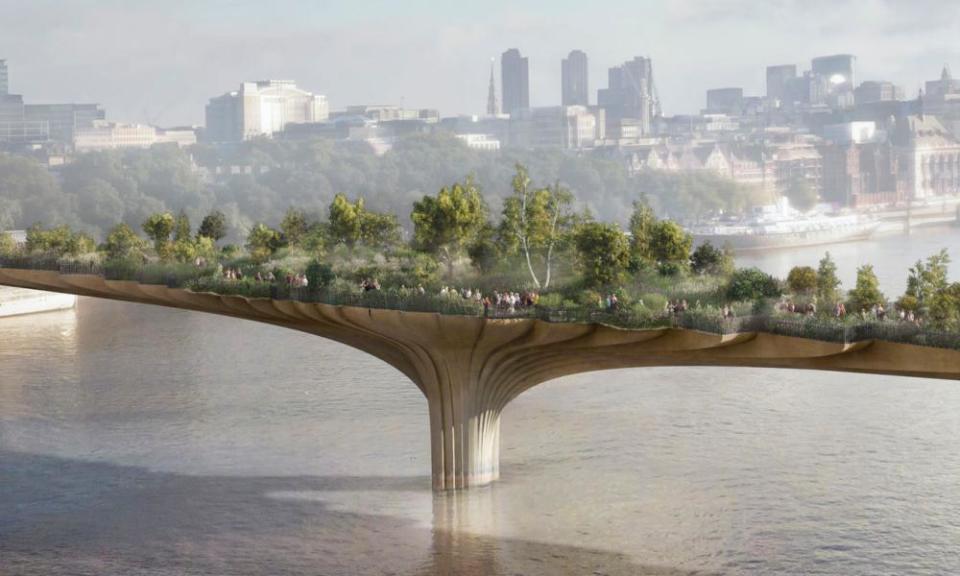The garden bridge is dead – now £37m of public money must be repaid

Varnished with a Kevlar coating of celebrity sparkle, Bullingdon Club backing and architectural fairy dust, the garden bridge has always seemed capable of surviving every missile of common sense thrown at it. For three years it has been fiercely opposed by supporters of gardens and bridges alike, of which this vanity project was clearly never either. But now it seems its invincibility cloak has finally worn off, as London’s mayor, Sadiq Khan, has refused to guarantee further funding for his predecessor’s misguided folly.
Launched as a privately sponsored gift to the city, Joanna Lumley’s “tiara for the Thames” had soon gobbled up £60m of public cash and the promise of an extra £3.5m a year for evermore. It was quickly revealed to be more a corporate events space than public crossing, a planted branding opportunity just 200 metres from an existing bridge, where groups would have to register and visitors would be tracked via their mobile phones. It was relentlessly exposed to be the product of the “chumocracy”, flouting all the usual rules of procurement. The miracle is that it ever got so far, and that so much public money has already been flushed into the Thames.
The blame lies firmly with former mayor Boris Johnson, the one actor in this sorry saga who refused to comply with Margaret Hodge’s recent inquiry into the project. Her investigation found multiple failings from the start, from the Garden Bridge Trust’s shaky business case (which put a lot of faith in the lucrative potential of selling T-shirts and pens), to a tendering process that was “not open, fair or competitive”, to confusion as to what the project was even for, concluding that the bridge should be scrapped before it burned through any more cash. And it all comes back to Boris.

It was Johnson who took up his childhood chum Lumley’s idea for the sylvan crossing (which was initially conceived as a memorial to Princess Diana and pitched to Ken Livingstone, who had the good sense to say no) and had it bulldozed through the system with flagrant disregard for due process. Hodge’s report found that his deputy mayor for transport, Isabel Dedring, and Transport for London’s director of planning, Richard de Cani, saw to it that the choice of Lumley’s team of Thomas Heatherwick and engineering giant Arup was a foregone conclusion. The team was allowed to revise their bid while their competitors were not, the scoring was found to be irregular, while de Cani admitted that he alone judged the bids.
In a move that has raised concerns over conflict of interest, both Dedring and de Cani now enjoy senior positions at Arup, where most of the £37.4m of public funding spent to date has been funnelled; TfL and the department for transport have both denied any such conflict.
Hodge also raised concerns over the private interests of the garden bridge trustees, who appeared to have business interests on both sides of the river where the bridge was due to land. The project’s business case spoke of a 5% increase in the value of property and a 30% increase in revenues for retail units, revealing the green tiara as a cynical garnish for raising land values in these central London areas – which the trust preposterously described as being “in need of regeneration”.
As the champion of novelty infrastructure projects, Johnson saw in the garden bridge his chance for another trinket to furnish his mantelpiece of ill-conceived urban ornaments. It would be a fitting addition to the empty Emirates Air Line cable car, his fleet of overheating Heatherwick-designed buses and the lunatic tangle of the ArcelorMittal Orbit sculpture in the Olympic Park. They are all projects characterised by the promise of private sponsorship that have ended up draining the public purse, standing as costly monuments to Johnson’s self-promotion.
By refusing the guarantee of further public funding for the garden bridge, Khan has effectively pulled the plug: since major private donors have pulled out, the project has a £70m funding gap and its planning permission expires in December. But he must go further and hold those responsible to account; we must insist that the lake of public cash already drained into consultants’ fees and building full-scale prototypes is repaid.
“It has the potential to be the slowest way to cross the river, with intimate moments and a lingering scale,” rhapsodised Thomas Heatherwick when I first met him to see his garden bridge plans in June 2014. He added with a twinkle in his eye: “It feels like we’re trying to pull off a big crime.” The conclusion of this long drawn-out public heist should be that crime doesn’t pay.

 Yahoo News
Yahoo News 